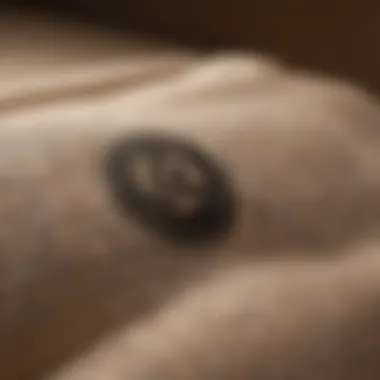Effective Strategies to Eliminate Body Odor from Clothing


Intro
Body odor can be a persistent problem, often clinging to clothing even after washing. Understanding the source of these odors is crucial to finding effective solutions. When sweat interacts with bacteria, it can create unpleasant smells. Fabrics like cotton and polyester can absorb these odors, making it difficult to maintain freshness. This article explores methods to effectively eliminate body odor from clothing, offering practical solutions using both household items and commercial products.
To address this issue comprehensively, we will examine various causes of odor retention, discuss efficient washing techniques, and outline preventative measures. This information is designed for homeowners and individuals seeking to maintain their wardrobe in optimal condition.
Preface to Body Odor in Clothing
Understanding body odor in clothing is essential for anyone who wants to maintain a fresh-smelling wardrobe. Body odor can be an uncomfortable topic, yet it affects all of us at some point. It stems from sweat, bacteria, and the type of fabric we wear. Inadequate measures to combat this issue can lead to persistent smells, making it a concern not just for personal comfort but also for social interactions.
Understanding Body Odor
Body odor occurs when sweat reacts with bacteria on the skin. When the sweat is produced, it is usually odorless. However, as it breaks down, bacteria consume the sweat and produce waste. This decomposition can happen swiftly, especially in warm and humid conditions. This is why understanding how sweat interacts with our clothing is important.
Clothing can inadvertently hold on to these smells, making it seem like they are part of the fabric. This is particularly true for synthetic materials such as polyester or nylon, which do not allow sweat to evaporate as efficiently as natural fibers like cotton. This understanding guides us to take better care of our garments, ensuring they remain fresh.
Why Clothes Retain Odor
The retention of body odor in clothes is primarily linked to fiber composition and laundry practices. Synthetic fabrics tend to trap moisture and allow for bacterial growth, making them more susceptible to odors. On the other hand, natural fibers typically breathe better and dry faster.
Another aspect to consider is the effectiveness of washing techniques. Using the wrong detergent or washing at inadequate temperatures can leave residues and fail to eliminate odor-causing bacteria.
When clothes are not washed promptly after heavy sweating or remain damp for an extended time, the smell can intensify. Bacteria thrive in these conditions, leading to unwanted odors permeating the fabric, proving that regular maintenance and careful washing are vital.
"Persistent body odor in clothing is not just a personal bother but can also affect one's social interactions and self-esteem."
Identifying the Source of Odor
Identifying the source of odor is crucial in the quest to eliminate unpleasant smells from clothing. Understanding where odors originate helps in applying targeted solutions. When one comprehends the specific factors contributing to odor retention, they can make informed decisions. Not only does this save time, but it also elevates the efficiency of odor removal efforts, leading to fresher, more pleasant clothing.
Types of Fabrics and Odor Retention
Different fabrics react differently to sweat and odor-causing bacteria. Natural fibers, such as cotton and linen, are generally more breathable. They allow air to circulate, which helps evaporate moisture quickly. On the other hand, synthetic fabrics like polyester and nylon retain sweat longer. This retention often leads to lingering odors. This is important for individuals looking to purchase new clothing. Selecting fabrics wisely can prevent future issues with odor retention.
- Natural Fabrics:
- Synthetic Fabrics:
- Cotton
- Linen
- Bamboo
- Polyester
- Nylon
- Acrylic
When choosing clothing, consider how the fabric will respond to sweat. This allows individuals to prioritize comfort while also minimizing odor retention.
Role of Sweat and Bacteria
Sweat itself is mostly odorless. The problem arises when bacteria on the skin break down the proteins and fatty acids found in sweat. This breakdown produces by-products that are smelly. The skin flora varies from person to person. This distinction means that everyone may experience different levels of odor in clothing, based on their unique sweat composition.
Several factors influence sweat production and bacterial growth:
- Diet: Consuming spicy foods or alcohol can increase body odor.
- Hygiene Practices: Regular washing and grooming can reduce bacteria levels on the skin.
- Environmental Conditions: High humidity and heat increase sweating.


"Understanding the interaction between sweat and bacteria provides insight into the best methods to combat body odor."
Knowing how sweat interacts with the fabric and bacteria enhances the ability to select the appropriate washing methods and detergents. This understanding is necessary for anyone wanting to keep their wardrobe odor-free.
Effective Washing Techniques
Effective washing techniques play a crucial role in eliminating body odor from clothing. Many homeowners often overlook the scientific aspects of these techniques. Understanding the right methods can lead to fresher clothes and a more pleasant environment. Each technique is not merely a suggestion but a necessity for achieving optimal results. The methodical application of these processes can also enhance the longevity of the fabric while ensuring their necessary cleanliness.
Choosing the Right Detergent
The choice of detergent is a foundational element in the washing process. Not all detergents are formulated the same. Some are aimed at removing tough stains, while others focus specifically on odor elimination. When selecting a detergent, it is essential to look for those containing enzymes designed to break down odor-causing compounds.
- Bio-based detergents are often more effective for this purpose. They utilize natural enzymes that digest organic stains and odors.
- Liquid detergents penetrate fabrics better than powders, enhancing their effectiveness. Therefore, choosing a liquid detergent may yield better results against stubborn odors.
- Additionally, read labels to find detergents labeled as "odor eliminators," as they are often formulated specifically to tackle body odor issues.
Optimal Washing Temperatures
The temperature of the water used during washing significantly impacts odor removal. Most bacteria thrive within a certain temperature range. Using hot water can be effective in killing these microorganisms, but it depends on the fabric type.
- Cotton and linens can generally handle hot washes, which helps to sanitize the fabric.
- Synthetic fibers may require cooler temperatures to maintain their integrity. Washing them in warm water can effectively balance odor removal and fabric care.
- It is also important to note that cold water can still be useful when paired with the right detergent, ensuring that efficient cleaning occurs without harming the fabric.
The Impact of Soaking and Pre-treating
Soaking and pre-treating garments is an often undervalued step in the process of dealing with body odor. This method allows the cleaning agents to penetrate the fabric deeply and work on odor more effectively.
- Pre-treating stains before washing can yield far better results. Simply apply a small amount of detergent to the affected areas, let it sit for a few minutes before washing. This aids in breaking down lingering odors.
- Soaking clothes in a mixture of water and vinegar can also help lift stubborn odors. A typical ratio would be one cup of white vinegar per gallon of water. Leave the garments to soak for about thirty minutes before proceeding to wash them.
- Lastly, do not rush the washing process. Allow adequate time for soaking and pre-treatment, as this makes the overall washing much more effective and thorough.
Proper washing techniques can drastically change the way clothes smell and enhance their overall lifespan. Paying attention to these details can save time and frustration in the long run.
Household Remedies
Household remedies are valuable when it comes to tackling the issue of body odor in clothing. They often use common items found in the home, making them cost-effective and easily accessible. The natural properties of these ingredients can neutralize odor and restore freshness without relying on harsh chemicals. This focus on household solutions also emphasizes an environmentally friendly approach to garment care.
Baking Soda as an Odor Neutralizer
Baking soda is well-known for its ability to absorb odors. This is due to its alkaline nature, which helps neutralize acidic compounds that contribute to unpleasant smells. Using baking soda in the wash is quite simple. Just add half a cup to your laundry load along with your usual detergent. It will enhance cleaning power and ensure a fresher outcome.
In addition to adding baking soda during washing, it can be used as a pre-treatment. Create a paste by mixing baking soda with water and apply it directly to the affected areas. Let it sit for about 30 minutes before washing as usual. This tactic works particularly well on sweat stains, which are often the underlying cause of lingering odors.
Vinegar Solutions for Freshness
Vinegar is another powerhouse in odor elimination. Its acetic acid content helps to break down odor-causing substances. When added to the washing machine, vinegar can aid in neutralizing smells while also acting as a fabric softener. Just add one cup of white vinegar during the rinse cycle to enjoy its full benefits.
Furthermore, vinegar can be diluted with water in a spray bottle to create a homemade fabric freshener. This solution can be lightly misted on clothing or stored fabrics, helping to refresh them without washing. It’s effective at combating stubborn odors and adding an extra layer of cleanliness to your garments.
Essential Oils and Their Benefits
Essential oils provide a fragrant way to combat body odor in clothing. Oils such as lavender, tea tree, and eucalyptus possess antimicrobial properties, making them effective against the bacteria that often produce odor. A few drops of your chosen essential oil added to the washing machine can result in fresh-smelling clothes.
Additionally, creating a spray by diluting essential oils in water offers a quick touch-up for clothes that might need a refresh. The scents can also promote a sense of well-being and relaxation. However, caution is necessary; always test a small fabric area first to ensure there are no adverse effects on colors or fabric.


In summary, employing household remedies like baking soda, vinegar, and essential oils not only helps in eliminating body odor from clothing but also promotes a healthier and more sustainable approach to garment care.
These remedies allow homeowners to tackle odors efficiently, using options that blend seamlessly into their daily routines while maximizing the cleanliness of their clothing.
Commercial Products for Odor Elimination
The choice of commercial products for odor elimination plays a crucial role in effectively addressing body odor in clothing. While household remedies serve their purpose, many consumers find that specialized products can provide targeted solutions and enhanced efficacy. Understanding the specific attributes of these products, alongside their benefits and considerations, is essential for homeowners seeking optimal freshness in their garments.
One of the primary advantages of commercial odor-eliminating products is their formulation. Many of these sprays and additives are designed by chemists who specialize in textile care. They utilize advanced odor-neutralizing compounds that are often more effective than standard detergents. This is particularly beneficial for those who engage in physical activities, as their clothing tends to retain more pronounced odors due to sweat.
When selecting a fabric spray, the application method and the drying time should also be considered. Some sprays are designed for immediate use, providing quick results before an important event. Others may require longer drying times but promise a deeper penetration into the fabric.
Choosing the Right Fabric Spray
Selecting the appropriate fabric spray can significantly influence the overall effectiveness of odor removal. Look for sprays that specifically mention 'odor elimination' rather than merely 'fragrance.' This distinction is crucial—many products may simply mask odors with strong scents, while the best fabric sprays actively neutralize the source of the smell.
Another aspect is the ingredients. Opt for sprays containing natural ingredients, such as baking soda or essential oils, if you have sensitive skin or prefer a more eco-friendly approach. Such options are often free from harsh chemicals that can irritate the skin or damage clothing.
Here are some key points to consider when choosing a fabric spray:
- Ingredient transparency: Look for sprays with labeled ingredients.
- Usage versatility: Some sprays can be used on multiple fabric types.
- User reviews: Check testimonials to gauge effectiveness and satisfaction.
Odor-Removing Laundry Additives
Alongside fabric sprays, odor-removing laundry additives are another category worth exploring. These products can be added during the wash cycle and enhance the cleaning power of regular detergent. They come in various forms, such as powders, liquids, or pods.
When selecting an additive, consider formulations that are compatible with your washing machine type and your clothing fabrics. Some additives are specifically designed for high-efficiency machines, while others might be better suited for traditional top-loaders.
Additionally, effectiveness varies. Certain products can target specific odors, like smoke or pet-related smells, while others provide broad-spectrum odor elimination.
Tips for Selecting the Right Laundry Additive:
- Check for compatibility with fabrics: Ensure it is safe for the materials you usually wash.
- Research effectiveness claims: Look for products backed by scientific testing or consumer reviews.
- Consider sensitivity: Choose unscented options when allergies or sensitivities are a concern.
Overall, commercial products for odor elimination in clothing offer a range of solutions that can significantly enhance garment freshness. Thorough research and careful selection can make a substantial difference in maintaining clean and pleasant-smelling textiles.
Preventive Measures
Preventive measures play a crucial role in maintaining the freshness of clothing, especially in the context of body odor elimination. Addressing potential issues before they escalate can save time and effort in the future. This section outlines specific elements, benefits, and considerations regarding how to keep clothes smelling clean.
Choosing Breathable Fabrics
Selecting breathable fabrics is essential when aiming to reduce body odor in clothing. Natural fibers like cotton and linen allow air circulation, which can help dissipate sweat and moisture. Synthetic materials, although often more affordable, trap heat and hold onto odor. Always check the fabric content before making a purchase.
- Cotton: Natural and breathable, good at absorbing sweat.
- Linen: Allows airflow, keeping the body cool.
- Bamboo: Eco-friendly and antibacterial, minimizing odor accumulation.
Opting for these fabrics, especially in warm climates or during physical activities, can significantly reduce the chances of unpleasant smells in clothing.
Cooling and Drying Techniques


Cooling and drying techniques are vital in preventing body odor from building up in clothing. After washing, it is important to dry clothes properly. Keeping garments in a damp place can encourage bacteria growth, which contributes to odor retention. Here are some effective techniques:
- Air Drying: Hang clothes outdoors when possible. Sunlight not only helps in drying but also acts as a natural disinfectant.
- Use a Dehumidifier: In humid environments, a dehumidifier can help maintain low moisture levels, inhibiting bacteria growth.
- Circulate Air: Ensure proper ventilation when drying clothes indoors. Open windows or use fans to promote airflow.
By implementing these practices, you can effectively reduce the chances of body odor lingering on your clothing.
Proper Storage Solutions
Proper storage is also integral in the fight against body odor. How clothes are stored impacts their freshness over time. Consider the following strategies:
- Clean Clothes Before Storing: Always wash garments before putting them away for long periods. Remaining sweat and dirt can fester and create odors.
- Use Breathable Storage Containers: Avoid plastic bags or airtight bins. Consider using fabric storage bags to keep air moving around the clothing.
- Include Moisture Absorbers: Silica gel packets or activated charcoal can be included to help reduce humidity levels in storage areas.
By following these strategies, you can maintain a crisp and fresh scent in your clothing, safeguarding them from long-term odor issues.
Maintaining Freshness Over Time
Maintaining freshness in clothing is vital for ensuring that garments remain wearable and pleasant. This involves understanding various factors that contribute to the persistence of odors and takes into account continuous care strategies. Regular practices not only help in managing body odor but also enhance the longevity of the fabric. With an increased focus on personal hygiene and environmental conditions, keeping clothing fresh becomes a necessary task for every homeowner.
The Importance of Washing Frequency
Washing frequency plays a crucial role in odor control. Depending on the activity level and the type of fabric, more frequent washing may be required. For instance, activewear absorbs sweat and odors quickly. Therefore, washing these items after each use is advisable. On the other hand, less frequently worn garments, like formal wear, may require less frequent cleaning.
A general guideline for most clothes is to wash them after three to four wears unless they visibly show dirt or smell. Regular laundering not only removes body oils and sweat but also minimizes the risk of bacteria growth that leads to persistent odor. Following care labels and recommendations will help in maintaining fabric integrity while ensuring freshness.
Monitoring Closet Conditions
Closet conditions significantly influence the freshness of clothing. Poor air circulation and high humidity can lead to musty odors. It is essential to keep closets well-ventilated by occasionally opening doors or using dehumidifiers if necessary.
Use breathable garment bags for items like suits or dresses. These allow air to circulate while protecting the clothes from dust and moisture. Furthermore, organizing garments by fabric type can help in proper air circulation, reducing the potential for odor retention.
Using Moisture Absorbers
Moisture absorbers are valuable tools in combating odors in clothing stored in closets or drawers. Silica gel packets, activated charcoal bags, or specially designed moisture absorbers can be placed within the storage areas. These products work by attracting and trapping moisture from the air.
The use of these absorbers not only reduces humidity but also helps prevent mold and mildew growth, which can lead to unpleasant smells. Replacing or recharging these absorbers regularly ensures ongoing efficacy. Simply placing them in your closet or drawer can make a noticeable difference in the overall freshness of your clothing.
"Regular maintenance of clothing and storage environments is essential to combating body odor effectively."
Ultimately, maintaining freshness over time involves a combination of appropriate washing frequency, careful monitoring of storage conditions, and effective use of moisture absorbents. These strategies contribute toward a wardrobe that is not only odor-free but one that remains in good shape long-term.
Ending
The topic of eliminating body odor from clothing holds a significant place in maintaining personal hygiene and fabric longevity. This article has meticulously highlighted the underlying causes of odor retention and presented effective strategies to tackle this common issue. The approaches discussed span from understanding the sources of odor to practical and preventive methods for ensuring clothing remains fresh.
Summarizing Key Points
In summary, several key points emerge from this exploration:
- Understanding Body Odor: Recognizing how sweat and bacteria interact is essential. The role of different fabrics in retaining odors cannot be overlooked.
- Washing Techniques: Choosing appropriate detergents and optimizing washing temperatures are critical steps.
- Household Remedies and Commercial Products: Both options offer viable solutions for tackling stubborn smells. Baking soda and vinegar are just as effective as specialized fabric sprays.
- Preventive Measures: Strategies like selecting breathable fabrics and incorporating moisture absorbers into storage spaces can significantly enhance freshness.
- Maintenance: Regular washing frequency, monitoring closet conditions, and utilizing moisture absorbers are vital for long-term odour control.
These elements collectively contribute to a holistic approach for managing odor in clothing.
Emphasizing Long-term Care
Long-term care is crucial for preventing body odor in clothing. It is not merely about addressing odors as they arise. Instead, it involves establishing and maintaining habits that prioritize cleanliness and fabric integrity. Different fabrics have their unique care requirements. For example, cotton may be more forgiving than synthetic materials when it comes to odor retention.
Moreover, adapting your habits to include regular inspection of your wardrobe, ensuring proper drying, and using appropriate storage solutions can make a noticeable difference. Incorporating these practices ensures that clothes not only remain fresh but also last longer. With a focused approach on both immediate remedies and preventive steps, one can enjoy the comfort of odor-free clothing and maintain a clean, pleasant environment.















